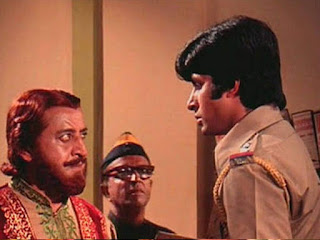The Zanjeer of Secularism
The cinema of syncretism is celebrated but not restricted to that of Manmohan Desai. Given the popularity of the secular trio of Amar, Akbar and Anthony, many people erroneously cite them as the first such syncretic trio. Among others, a similar, albeit shallower trio had come out four years earlier in the Prakash Mehra hit and the Bachchan stardom spawner Zanjeer.
 |
| Source: The Tallenge Store |
The film features three unrelated brothers in arms. Hindu Vijay Khanna, Muslim Pathan Sher Khan and Christian De Silva. All three conspire to find and eliminate Teja, the smart but dreaded don of the city.
 |
| Teja Source: Rediff |
Two parallel stories, two parallel traumas mark the plot of the film.
 |
| The aloof child, Vijay |
The first one is of a reclusive, aloof child, whose upright parents are gunned down in the camouflaged silence of the gun on a deafening firework filled, Diwali night. He grows up as the same sullen, plaintive boy drowned in the traumatic dream of a man astride a white horse, with a silver chain in his hand, because he apparently found these symbols on his parents' killers. The boy is Vijay, who later becomes a police officer, fighting crime so that it does not knock on his and anyone else's door again.
 |
| The tragic telltale tipsy. Om Prakash in one of his seminal cameos. Here as Mr. De Silva, the bereaved Christian father (with a small 'f''). |
The second one is of Mr. De Silva, who loses both of his young sons to a Christmas drink of poisoned moonshine. He avows revenge from his sons' killer, and taps Vijay from time to time regarding the whereabouts of the next crime scene.
Vijay and De Silva are joined in vigilance with the dear Pathan friend of Vijay's–Sher Khan. An erstwhile underground gambling den owner, Sher Khan gradually gains Vijay's trust and confidence and becomes an honest car mechanic and a dependable aide of Vijay through thick and thin.
These variegated paths of syncretism, traumas and moonshine, lead to the common villain's den. The suited-booted don-with-a-moll, Teja exudes an elitist indifference to the plight of gullible, honest commoners like Vijay's parents and De Silva's sons. This indifference and spite leads to Vijay being suspended from duty on fabricated charges of bribery. Out of police, in plainclothes, Vijay plans to exact vengeance, vigilante-style along with his faithful Sher Khan, the Pathan who is enough to knock off a regiment alone.
The compressed bottom line goes: a Hindu, aided by a Muslim, avenges himself and a Christian against a dreaded don.
It is not that religion is the halo-hegemon of the film. It exists on the periphery with its symbols adding flesh to the skeletal plot of the film. Vijay loses his family on the Hindu festival of Diwali, De Silva's small family is finished amidst Christmas cheer. Sher Khan, although not celebrating Eid in the film, dances dulcet with his pal Vijay with the qawwali "Yaari hai imaan mera, yaar meri zindagi". Although Pathan is not specifically a religious identity per se, but the qawwali seals the fact that Sher Khan is a Muslim, and a "good Muslim" as per modern Bollywood's binary of a Muslim being either a friend to the hero, or the main, terrorising fanatic antagonist of the film.
 |
| The din of death: The Diwali firecrackers act as metaphors for muted murders both at the beginning and end of the film. |
The final showdown of Zanjeer (Diwali night again) wherein Vijay and Sher Khan finish Teja and his goons and avenge De Silva, exudes the formulaic secularism which Bollywood later carried forward in Manmohan Desai's high pitched cinematic entertainers like Amar Akbar Anthony and Naseeb. While the former had three brothers of different faiths, the latter had a three-in-one: John Jaani Janardhan.
This cinema, which attracted millions to the cinema in its heydeys, now stands aloof and outwritten. As a boycotted, contrived cinema beheld by a polarised country.
Then again, if one looks at secularism: it is a primarily Western concept demarcating a clear binary between faith (mostly monotheistic faiths like Christiannity/Islam) and rationality. Can this concept be similarly implemented in a gigantic country like India (which is home to almost all the major faiths of the world)? Retro Bollywood has always pined for religious harmony and tolerance. These are noble sentiments, but can they be ushered in the ambit of a secular cinema?
Is the overt exhibition of religious symbols true to the secular notion of 70s Bollywood? It does fit in the narrative of Indian secularism of accepting all faiths. But is it really what secularism, as an ideology, sought ought to achieve?
It is a bittersweet complexity, the Zanjeer of secularism and secular Hindi cinema!




Comments
Post a Comment